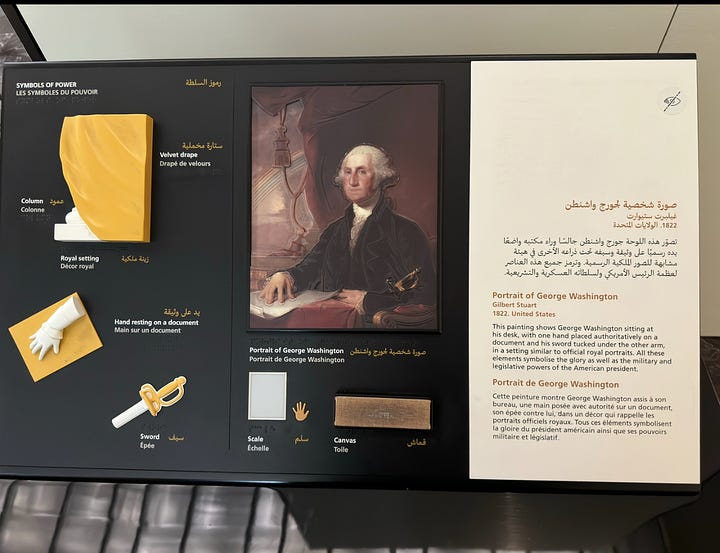Abu Dhabi - Curating a Vision of the Universal Civilization
Some very brief travel notes
Patrick Collison made an incisive tweet recently about the real benefit of travel. Unsurprisingly, he is right. I recently visited Abu Dhabi for the first time and what was striking, is that in a strange way, it felt more like a Western city than present day central London. This is not subtle. It is not Straussian. If you visit the Louvre Abu Dhabi you can see it.
If you start by thinking about the architecture the Louvre Abu Dhabi. It is designed to pay homage to the ocean.



It can be approached by land or sea. The French architect, Jean Nouvel, aimed to design a space that could encompass the grand theme of a palace of civilizations distributed by time and place.
In an interview, Nouvel explained his thinking behind the design:
When I started working on this project, I did not know it would be the Louvre, but that it would become a museum of civilizations—the plural of this word is important. I wanted a strong symbol, an immediate dialogue, a powerful spiritual dimension.
I then wanted an architecture that resonates with the history of the place by providing a direct echo in Arab architecture, but one that equally addresses universality. It is this synthesis that must be found.
And because architecture is an art, it would be quite mysterious, alluring enough to tempt the public to get lost and to go seek his or her own answers.
The centrality of water immediately reminds me of a paritcular philosophical concept of the Barbadian poet Kamau Brathwaite known as Tidalectics. The details of this would require a deep diversion into Hegelian dialects but this is not the place for that. The core idea I want to bring up here of Tidalectics is the poetic notion of how the ocean transfers human history across the globe. And therefore if you give prominence to the ocean in an artistic work, then you give a sense of universality to humanity.
So then, just from the building we already get a sense of the main theme being curated.
The permanent exhibit is even more explicit.
The prevailing theme is pluralism — a hat tip towards Western themes of Liberalism.
Showing that human civilizations across time and space have their own unique majesty but also there is a meta-majesty that comes through when you think of modern humans being able to inhabit and benefit from the confluence and knowledge that our different cultures can offer.




You see works from European, Chinese, Malian, and Mexican civilizations juxtaposed together. It forces you to think about the universality of humanity rather than the distinction of separate geographies.
Religion is also brought into this universal theme. Many rare and striking works of Christianity, Judaism, and Islam are brought together to show the theological congruence of the three. They even highlight a single category called Ahl al-Kitāb (People of the Book).



It is not surprising that religion takes a center stage in an important artistic institution in Abu Dhabi. But the way in which Christianity and others are given such prominence was a pleasant surprise to me. You would be hard pressed to find such expressions of religious primary and universality in major art institutions in the West today.
It shows that the curators were encouraged to be serious about universality. Throughout the museum there are these large windows that show the ocean around the museum with quotes etched on them. One that stood out to me that I thought truly represents the ambition of this gallery: “Art is the shortest path from man to man”.
There was even a section highlighting the importance of the founding of the United States of America, via the boldness and strength of a portrait of George Washington. (Random aside: the only country Washington traveled to outside of North America was Barbados - where I’m from.)


There is of course a lot more I could show and talk about from the exhibits. But I will highlight just one more. The final exhibit.
When leaving the permanent exhibition you are confronted with perhaps one of the best art-world pairings I have seen in a while - I audibly gasped when I saw it.
Since we should all be familiar with the work of Cy Twombly, I don’t have to explain it much here. But juxtaposing his abstracted art-writing with 4000 year old figurative wall engravings from Arabian shepherds is perhaps the apex of what an art curator can do. How can you not be optimistic about the future when you leave the exhibition?
V.S Naipaul would perhaps be confused to see this in the Middle East — but he would surely smiling.





Moving.🥹